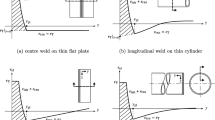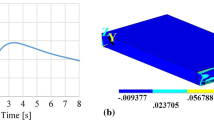Abstract
Residual stress in a welded plate is computed in the first part of the paper using a weld analysis software program VrWeld (www.goldaktec.com) that computes the 3D transient temperature field, the evolution of micro-structure and the evolution of stress-strain fields. The computed residual stress is compared to the residual stress distribution measured by Paradowska (J Mater Process 164–165:1099–1105, 2005) with a neutron diffraction method to show that the computational model captures the physics well. Two uncertainty analyses are conducted in the second part to investigate the question of how variations in parameters contribute to the result from part one provided that computational model can predict residual stress well resulted in part one. The difference between the two is the number of parameters. The former has only one parameter and we employed the computational model for perturbation analysis in order to find the uncertainty due to perturbation in the parameter. For such a test, the number of test required in sample space to approximate normality by central limit theorem, is feasible considering computational resources although it is not true when we have higher number of interrelated parameters. The latter therefore has 4 highly interrelated parameters to show that an alternative way can be employed instead of using directly computational model for such a case. Uncertainty analyses are based on Monte Carlo method in this paper and the idea is that if numerical modeling is valid and also there is a need for a great number of tests for Monte Carlo analysis that make it unfeasible to run such an analysis directly by computational model then extracting a regression model from the computational model and working with it, is an effective alternative.











Similar content being viewed by others
Notes
ASME V &V 10-2006, Guide for Verification and Validation in Computational Solid Mechanics, An American National Standard, The American Society of Mechanical Engineers.
References
Anderson, B.A.B.: Thermal stresses in a submerged-arc-welded joint considering phase transformation. Trans. ASME J. Eng. Mater. Technol. 100, 356–362 (1978)
Goldak, J., Akhlaghi, M.: Computational Welding Mechanics, Springer, ISBN 0-387-23287-7 (2005)
Goldak, J.A., Chakravarti, A., Bibby, M.J.: A new finite element model for welding heat sources. Trans. AIME 15B, 299–305 (1984)
Gu, M., Goldak, J.: Steady state formulation for stress and distortion of welds. J. Eng. Ind. 116, 467–474 (1994)
Gur, C.H., Pan, J.: Hand Book of Thermal Process Modelling of Steels. CRC Press, London (2008)
Henwood C., Bibby M.J., Goldak J.A., Watt D.F.: Coupled transient heat transfer—microstructure weld computations (Part B). Acta Met. 36(11), 3037–3046 (1988)
Iron, B.F., Ahmad, S.: Techniques of Finite Elements, Ellis-Horwood Limited. ISBN 0-85312-130-3 (1980)
Kirkaldy, J., Venugoplan, D.: Prediction of micro-structure and hardenability in low alloy steels, phase transformation in ferrous alloys. In: Proceedings of International Conference, 4–6 Oct 1983
Kumar, R., Coulombe, M., Tchernov, S., Goldak, J.A., Johnson, E., El-Zein, M.: A model equation for the convection coefficient for thermal analysis of welding structures. In: 8th International Trends in Welding Research, Callaway Gardens Resort, Pine Mountain, Georgia, USA, 2–5 June 2008
Pan, J.: Arc Welding Control. Book published by Woodhead Publishing, ISBN 185573687X (2003)
Paradowska, A., Price, J.W.H., Ibrahim, R., Finlayson, T.: A neutron diffraction study of residual stress due to welding. J. Mater. Process. 164–165, 1099–1105 (2005)
Simo, J.C.: Numerical analysis of classical plasticity. In: Ciarlet, P.G., lions, J.J. (eds.) Handbook for Numerical Analysis, vol. IV. Elsevier, Amsterdam (1988)
Watt, D.F., Coon, L., Bibby, M.J., Goldak, J.A., Henwood, C.: Modelling microstructural development in weld heat-affected zones (Part A). Acta Met. 36(11), 3029–3035 (1988)
Author information
Authors and Affiliations
Corresponding author
Rights and permissions
About this article
Cite this article
Asadi, M., Goldak, J.A., Nielsen, J. et al. Analysis of predicted residual stress in a weld and comparison with experimental data using regression model. Int J Mech Mater Des 5, 353–364 (2009). https://doi.org/10.1007/s10999-009-9107-5
Received:
Accepted:
Published:
Issue Date:
DOI: https://doi.org/10.1007/s10999-009-9107-5




